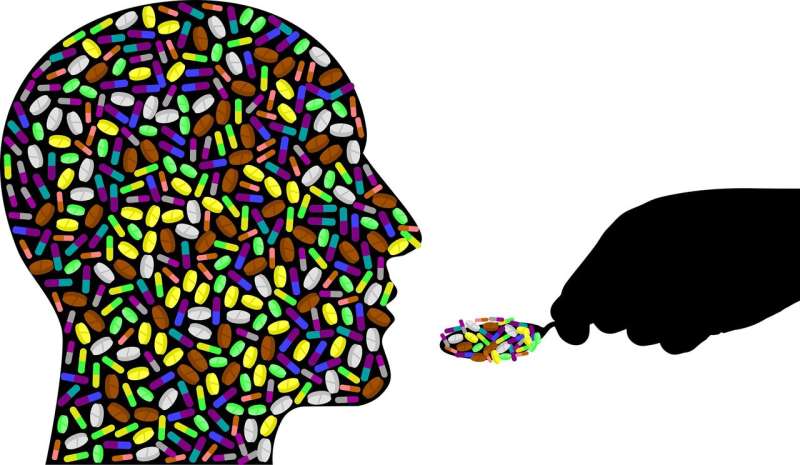Credit: CC0 Public Domain
About 4 million people who reported use or misuse of prescription opioids or heroin in 2014 also reported having a concurrent arrest or active probation or parole status. Individuals who report opioid use are significantly more likely to have been arrested compared to those who do not use opioids.
Opioid agonist treatments, which includes federally approved medications such as methadone, buprenorphine and naltrexone, reduce withdrawal symptoms and cravings as well as block the effects of opioid use and reduce the risk of death by 33%. Yet, this treatment among justice-involved individuals is relatively rare.
Researchers from Florida Atlantic University's College of Social Work and Criminal Justice and collaborators conducted a study on the differences between criminal justice-involved individuals who received opioid agonist treatment as part of their treatment plan and those who did not. They compared demographics, substance use severity, and access to treatment and identified predictors of treatment to account for disparities within a criminal justice population in the United States.
The nationally representative database they used comprised of 105,988 admissions referred to treatment by the criminal justice system who reported heroin or other opiate as their primary, secondary, or tertiary substance used.
Results of the study, published in the journal Substance Use & Misuse, showed that fewer than 6% of criminal justice cases received opioid agonist treatment as part of the treatment plan. Those with daily substance use, comorbid psychiatric problems, prior treatment, females, Latinos, and those who were older and those who were living independently were more likely to receive this treatment, as were those living in the Northeast and with government health insurance.
"The criminal justice system is well-positioned to facilitate an individual's engagement in effective care at several intervention points including contact with first responders, case adjudication, sentencing, supervision and reentry," said Wendy P. Guastaferro, Ph.D., senior author, director and associate professor, FAU School of Criminology and Criminal Justice. "We know that opioid agonist treatment is related to better outcomes for justice-involved individuals, including reduced opioid use, reduced overdose deaths, improved treatment engagement, reduced criminal behavior, and lower crime costs. However, only a fraction of justice-involved individuals receive this treatment even though its effectiveness is well-established."
Among the study findings:
- The majority of the sample were poly-drug users who reported heroin as a drug of choice and had previously received substance use treatment. Yet, opioid agonist treatment was not part of the treatment plan for the overwhelming majority of these cases (95%).
- In 2014, more than 100,000 criminal justice system cases had an opioid use disorder diagnosis, but 15 states did not have a certified opioid treatment program.
- Only 15% of U.S. counties were reported to have licensed opioid treatment programs that dispense methadone and nearly half of all U.S. counties do not have a physician approved to prescribe or dispense buprenorphine.
- The opioid agonist treatment group included more individuals who were covered by government-issued insurance or did not have any insurance compared to those with private insurance.
- Older individuals had significantly greater odds of receiving treatment compared to young adults. These findings lend some support to the notion that treatment is reserved for those who are more likely to be successful or are considered more "deserving" of treatment as age often is associated with reduction of criminal behavior.
- For women, 5% of those who received treatment in their treatment plan were pregnant at the time of admission compared to 1.5% of those who did not have opioid agonist treatment in their treatment plan.
- Even in states where opioid agonist treatment is available, criminal justice system-referred cases in the West and Midwest regions of the U.S. were markedly less likely to receive opioid agonist treatment than their counterparts in the Northeast.
- Latinos were statistically more likely to receive opioid agonist treatment as part of their treatment plan.
- Nearly 26% of the study sample were flagged for alcohol use at intake, but were less likely to be in an opioid agonist treatment program.
Although largely framed as a problem that affects white individuals, opioid use has had significant and growing impact on nonwhite communities as well. Between 2010 and 2018, opioid overdose deaths increased 355% among black individuals and 218% for Hispanic individuals.
"Dismantling barriers to treatment can improve both public health and community safety," said Guastaferro. "The criminal justice system must reduce regulatory burdens and systemic resistance to opioid agonist treatment while increasing funding for access to treatment to effectively serve those struggling with opioid use disorder."
More information: Wendy P. Guastaferro et al, Opioid Agonist Treatment Recipients within Criminal Justice-Involved Populations, Substance Use & Misuse (2022). DOI: 10.1080/10826084.2022.2034869
Provided by Florida Atlantic University
























